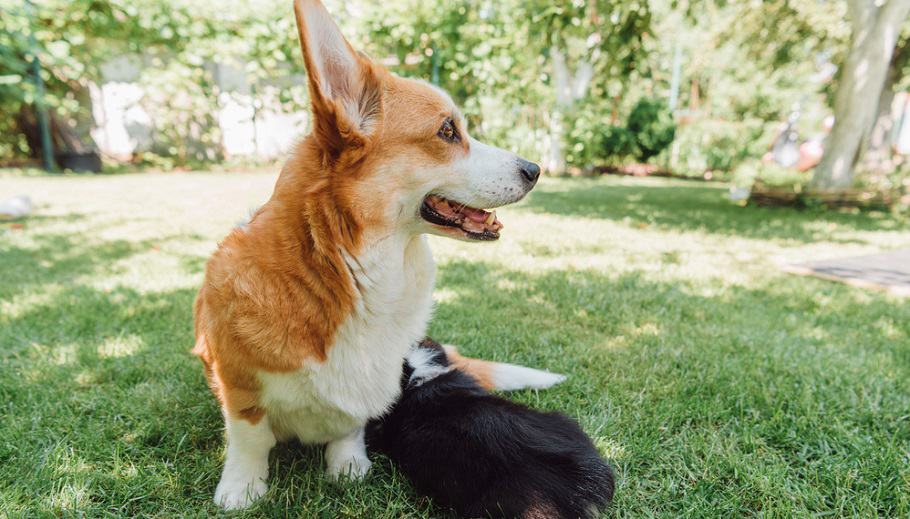How Big Will My Puppy Get – Puppy Growth Calculator
Whenever you get a new puppy and bring them home, at some point you will begin to ask yourself ‘how big will my puppy get‘?
It can be hard to predict the adult size of your puppy and even more complicated when you are deciding their adult size especially if they are a mixed breed.
Knowing how big your puppy will get enables you to prepare for the future in terms of the amount of food they need, how much space or exercise they need as well as deciding on the size of the crate or harness to buy.
This article will give you more information on how you can estimate your puppy’s adult size when they stop growing based on their breed size, and factors that can affect their final size.
Different Ways To Estimate Your Dog’s Adult Size

1. Puppy Growth Calculator
You can use a growth calculator to determine the adult size of your puppy. There are general rules and calculations to follow when estimating the adult size of your puppy based on their breed and/or size.
Toy breeds such as Maltese, Chihuahua, Pomeranian, or Pekinese, have the fastest growth compared to other breeds. To estimate their adult weight, take their weight at 6 weeks and double it twice.
For example, if your 6-week-old puppy weighs 2 pounds, they will weigh 8 pounds as adults (2×2=4, 4×2=8).
Small breeds such as Dachshund, Beagle, Jack Russel Terrier, and French Bulldog, have most of their growth happen between 0 and 11 weeks. Use the same calculation as the toy breed to find their adult weight.
Medium breeds like Cocker spaniel, Border Collie, and Bulldog, grow rapidly between the ages of 0 and 16 weeks. Double their weight at 14 weeks, then add half of their 14-week weight to the result to find their adult weight.
For example, if your puppy weighs 12 pounds at 14 weeks, their adult weight calculation will be 12×2=24, 24+6=30 pounds when fully grown.
Large breeds like Bloodhound, Boxer, German Shepherd, Doberman Pincher, and Golden Retriever, have the majority of their growth between the ages of 0 and 20 weeks.
Double their weight at 6 months to find their adult weight. For example, if your puppy is 40 pounds at 6 months, they will weigh 80 pounds as adults.
Giant breeds such as Irish Wolfhound, Great Dane, and Mastiff, take longer to reach their adult size and their fastest growth happens between the ages of 0 and 25 weeks.
To find their adult weight, divide their weight at 20 weeks old by their current age in weeks then multiply the result by 52. So, if your puppy at 20 weeks weighs 40 pounds, their adult weight will be calculated as 40÷20=2, 2×52=104 pounds.
2. Follow A Puppy Growth Chart

A puppy growth chart can help you determine the adult size of your puppy. Using a puppy growth chart for any specific breed whether a toy, small, medium, large, or giant, look at your puppy’s age which is on the left column, then find the nearest weight associated with their age. Next, go down on the weight column to see their weight as adults.
Toy breeds add between 5% and 10% of their current body weight daily which is about 1 to 6 oz weekly. For instance, if your puppy weighs 39 oz at 12 weeks, their adult weight will be 5 pounds.
Small breeds don’t grow as fast as toy breeds but grow faster than large breeds. Small breeds overlap at the lower end of the scale with toy breeds and the higher end with medium breeds.
Their weight gain rate is about 5% to 10 % of their weight daily which is about 5 to 8 ounces weekly. For example, if your puppy’s weight at 16 weeks is 7 pounds, their adult weight will be 20 pounds.
The medium breeds are dogs that weigh between 25 and 50 pounds as adults. Medium breeds overlap with the small breeds at the lower end of the scale and with large breeds on the upper end of the scale. So, if your puppy weighs 20 pounds at 6 months, their adult weight will be 40 pounds.
Large breeds comprise dogs that weigh between 50 and 100 pounds, and they overlap with medium dogs on the lower end and giant dogs on the upper end of the scale.
Large breeds still grow past the age of one year and may continue growing until they reach 18 months old. If your puppy weighs 31 pounds at the age of 5 months, they will weigh 105 pounds as adults.
Giant breeds take longer to reach their adult weight compared to other breeds and weigh above 100 pounds as adults.
Giant breeds on the lower end of the scale gain between 2 and 3 pounds weekly while those on the upper end of the scale gain 3 to 5 pounds every week. For example, if your puppy weighs 56 pounds at 6 months, their adult weight will be 165 pounds.
3. Look At The Parents
One of the best ways to estimate the adult height and weight of your puppy is to look at their mother and father. The parent’s grown weight and height are great determinants of what to expect from your puppy.
This is because puppies inherit the physical characteristics of their parents. Therefore, average the parent’s weight and height to get a good idea of how big your puppy will get when fully grown.
However, if you have not met the parent of your puppy, ask your breeder for this information because they will know.
4. Paw Size
The general rule of giant paws equals giant dogs may have partial truth but may not always be the truth. Some puppies with big legs and paws may grow to be big dogs while for some dogs this may not be the case.
This is because parts of the body grow at different rates and sometimes the paws can go through a growth spurt that other body parts have not yet caught up to.
5. DNA Test
If your puppy is a mixed breed, doing a DNA test can give you more information about their ancestry and help you answer the how big will my puppy get question.
A DNA test is also useful when you don’t know any information about your puppy’s parents as it will show you the genetic makeup of your puppy, then you can predict their adult age.
For mixed breed puppies such as German Shepherd Corgi, they cannot be smaller than Corgi or bigger than German Shepherds as adults.
When Do Puppies Stop Growing?

Puppies grow at different rates basing on their breed size. You may adopt a small dog, but they may grow over a long period to attain their adult size.
Likewise, you may get a dog thinking they are a big puppy, but you find out that they have already reached their adult size. Therefore, knowing the breed of your puppy will help you know when they stop growing.
Generally, bigger dogs take a long time to fully grow while smaller dogs take a shorter time to reach their adult size.
Toy Breeds
Toy breeds are the smallest dogs of them all and are likely to reach their sexual and physical maturity earliest. These dogs reach their adult size between the ages of 8 to 9 months. This is when they weigh up to 12 pounds.
Small Breeds
Small breeds stop growing sooner than large breeds. some stop growing at the age of 8 months while others take up to one year to reach their adult size. Between these ages, they will weigh between 12 and 25 pounds.
Medium Breeds
Medium breeds are fully grown when they reach the ages of 9 and 12 months. Their growth rate within the first year is faster and needs to be monitored to ensure that they get the right food for their needs. They weigh between 25 and 50 pounds as adults.
Large Breeds
Large breeds take between 12 and 18 months to reach their adult size and weigh between 50 and 100 pounds. They have a growth spurt between the ages of 8 and 14 months.
Giant Breeds
Some giant breeds stop growing between the ages of 12 and 18 months while others take around 2 to 3 years to attain their adult weight.
These are the dogs that weigh over 100 pounds as adults. They take the longest to reach their adult size compared to other breeds.
Giant breed puppies need space in terms of a backyard and a big home to comfortably mature.
Puppy Height Calculator

Typically, dogs reach their adult height before reaching their adult weight. When your puppy is 4 months old, their weight is 30% of their adult weight while their height is 60% of their adult height.
There is a calculation you can use to predict the adult height of your puppy. When your puppy is 6 months old, measure their height from the ground to the top of their shoulders, while ensuring that their legs are vertical, and they are standing straight.
Multiply the number you get from the measurement by 100 then divide the results by 75. This means that at 6 months, your puppy has achieved 75% of his adult height.
Does Spaying/Neutering Affect My Puppy’s Growth?
When done at the right time, spaying and neutering do not affect the growth of your puppy.
However, if done too early their growth can be affected because growth hormones work hand in hand with reproductive hormones to ensure the growth and development of your puppy.
For some puppies, if they are neutered before the age of 7 months, their testosterone is reduced causing delays in the closure of their growth plates. This may cause your puppy to grow taller and have issues with his joints.
Early spaying or neutering can reduce and slow down muscle development which is noticeable for most large breed dogs. This means that your puppy may be taller, but he may not reach his full potential in terms of muscle development.
Other Factors That Affect Puppy’s Final Adult Size

The following are other factors that may contribute towards the adult size of your puppy:
Gender
Gender in dogs can affect their development and weight gain as well as their adult size. The general rule is that male dogs are bigger than their female counterparts, with the males being larger in early adolescence while the females reach maturity faster.
The difference in size is usually small but is mostly clear in larger breeds than in toy or small breeds. Note that puppies from the same litter can vary in size, whether female or male, and can develop and grow at different rates.
Genetics
The genetic make-up of your puppy hugely affects their build, duration of their growth period as well as their adult size.
The growth rate of your puppy is determined by hereditary and other factors that contribute to his growth. Some genetic features are passed down from the parents to the puppies.
Some puppies grow faster while others grow slower. The size of the parents can give you an idea of the adult size of your puppy. Your puppy will be approximately the average size of their parents as adults.
This means that puppies whose parents are large dogs may take longer to reach their adult size and eventually have a larger size.
But this is not guaranteed as large parents can produce small puppies and vice versa.
Health & Nutrition
There is a reason why breeders, rescues, and veterinarians stress the importance of giving your puppy a well-balanced and good diet. There is a correlation between diet and your puppy’s final size.
Any estimate of your puppy’s weight assumes that they are fed well. Feeding your puppy food that does not have the proper nutrients or underfeeding them does not only affect their weight but can also slow their growth.
On the other hand, overfeeding your puppy can cause health problems such as obesity which is dangerous for them.
Obesity is caused largely caused by overfeeding but can also be caused by feeding your puppy the wrong foods such as those that contain fillers.
When your puppy is growing, they will go through the awkward stages where they appear round and plump then start to look skinny as they develop and grow.
This is normal and their food should not be changed. It is essential to seek help from your vet to know whether your puppy is on the right track in terms of his weight.
Purebred vs Mixed Breed Prediction Accuracy
Purebred puppies mean that their parents are from the same breed while mixed breed puppies mean that their parents come from different breeds.
You need to determine whether your puppy is purebred or mixed to be able to determine how big they will be as adults. Otherwise, you can wait until they are fully grown to know their adult size.
If you don’t know the mix of your puppy, it may be difficult to know how their genes will affect their size.
However, if you know that your puppy is a mix of two large breeds or two small breeds, you may be able to guess their adult weight, but it is just an estimate.
It can also be hard to predict the adult size of a purebred. This is because they could be the largest or smallest in their litter or grow at a slower or faster rate than other puppies of the same breed because of health conditions.
Researching the standards of your puppy’s breed club can help you understand how big they will be. Your vet can also help by giving you guidelines on what to expect as your puppy grows through the different milestones.
Final Words
Estimating the final size of your puppy may be a bit of a headache but using a puppy growth calculator and chart, looking at the parents and the paws, as well as doing a DNA test can give you an idea.
When your puppy stops growing depends on its breed size, whether giant, large, medium, small, or toy. Therefore, knowing the breed of your puppy is essential.
Other factors such as spaying, neutering, gender, genetics, health, nutrition, purebred, and mixed breed can affect the final size of your puppy.






